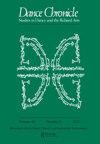巴兰钦的《俄耳甫斯》的奇异阴影(1948)
IF 0.1
3区 艺术学
0 DANCE
引用次数: 0
摘要
摘要本文考察了乔治·巴兰钦编舞的芭蕾舞剧《俄耳甫斯》(1948),以及围绕这部芭蕾舞剧创作的酷儿文化环境。虽然奥菲斯以帮助正式成立纽约市芭蕾舞团而闻名,但在芭蕾舞团发展过程中,同性恋的潜流在历史叙述中受到的关注较少。此外,演员尼古拉斯·麦哲伦斯(Nicholas Magallanes)同样被忽视了,他是一名同性恋墨西哥裔美国移民。因此,通过编舞分析和档案研究,我阐明了一群酷儿男子的集体影响,以断言俄耳甫斯的意义在于其酷儿的过去。本文章由计算机程序翻译,如有差异,请以英文原文为准。
Queer Shadows of Balanchine’s Orpheus (1948)
Abstract This article examines the ballet Orpheus (1948), choreographed by George Balanchine, and the cultural milieu of queerness surrounding the ballet’s creation. Although Orpheus is known for helping to formally establish the New York City Ballet, the undercurrents of homosexuality in the ballet’s development have received less attention in the historical narrative. Additionally, the dancer Nicholas Magallanes, a gay Mexican American immigrant who starred in the title role, is similarly overlooked. Thus, through choreographic analysis and archival research, I elucidate the collective influence of a constellation of queer men to assert that the significance of Orpheus lies in its queer past.
求助全文
通过发布文献求助,成功后即可免费获取论文全文。
去求助
来源期刊

DANCE CHRONICLE
DANCE-
CiteScore
0.40
自引率
0.00%
发文量
22
期刊介绍:
For dance scholars, professors, practitioners, and aficionados, Dance Chronicle is indispensable for keeping up with the rapidly changing field of dance studies. Dance Chronicle publishes research on a wide variety of Western and non-Western forms, including classical, avant-garde, and popular genres, often in connection with the related arts: music, literature, visual arts, theatre, and film. Our purview encompasses research rooted in humanities-based paradigms: historical, theoretical, aesthetic, ethnographic, and multi-modal inquiries into dance as art and/or cultural practice. Offering the best from both established and emerging dance scholars, Dance Chronicle is an ideal resource for those who love dance, past and present. Recently, Dance Chronicle has featured special issues on visual arts and dance, literature and dance, music and dance, dance criticism, preserving dance as a living legacy, dancing identity in diaspora, choreographers at the cutting edge, Martha Graham, women choreographers in ballet, and ballet in a global world.
 求助内容:
求助内容: 应助结果提醒方式:
应助结果提醒方式:


